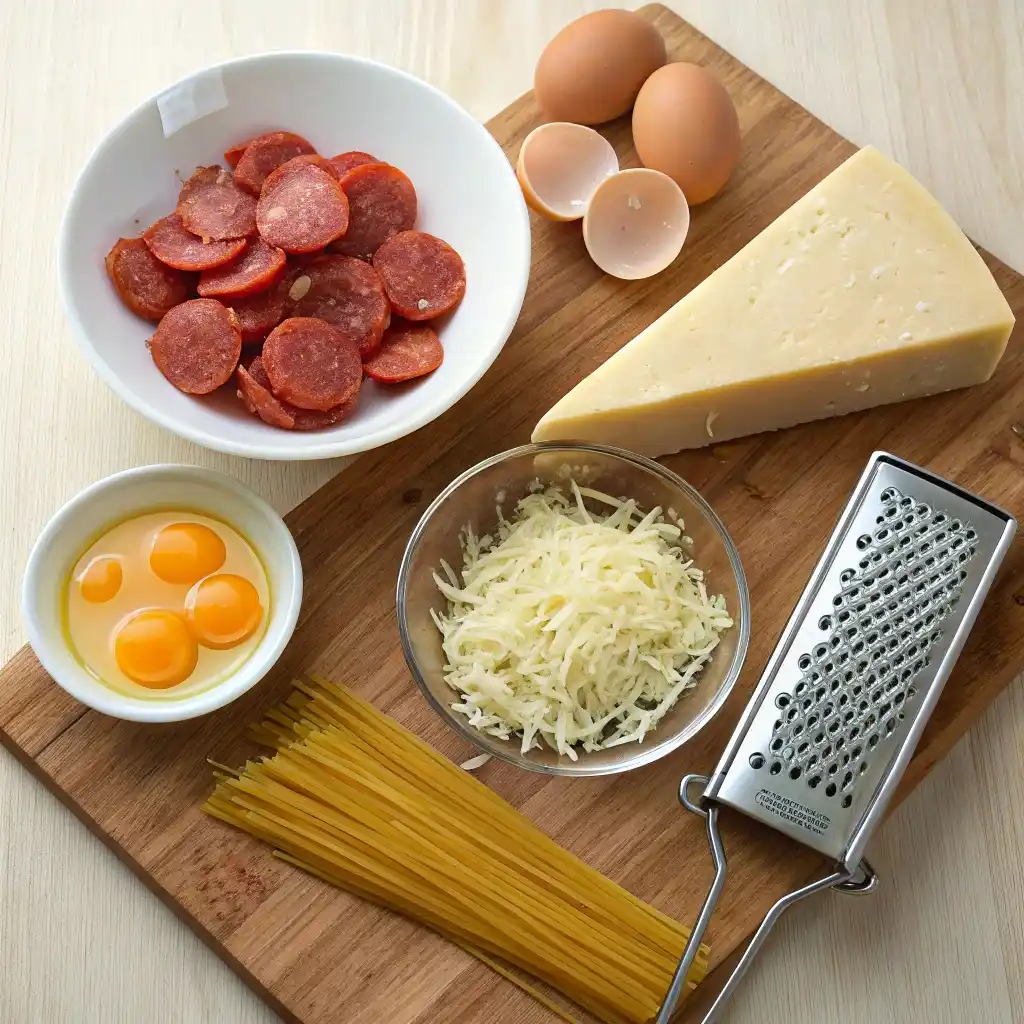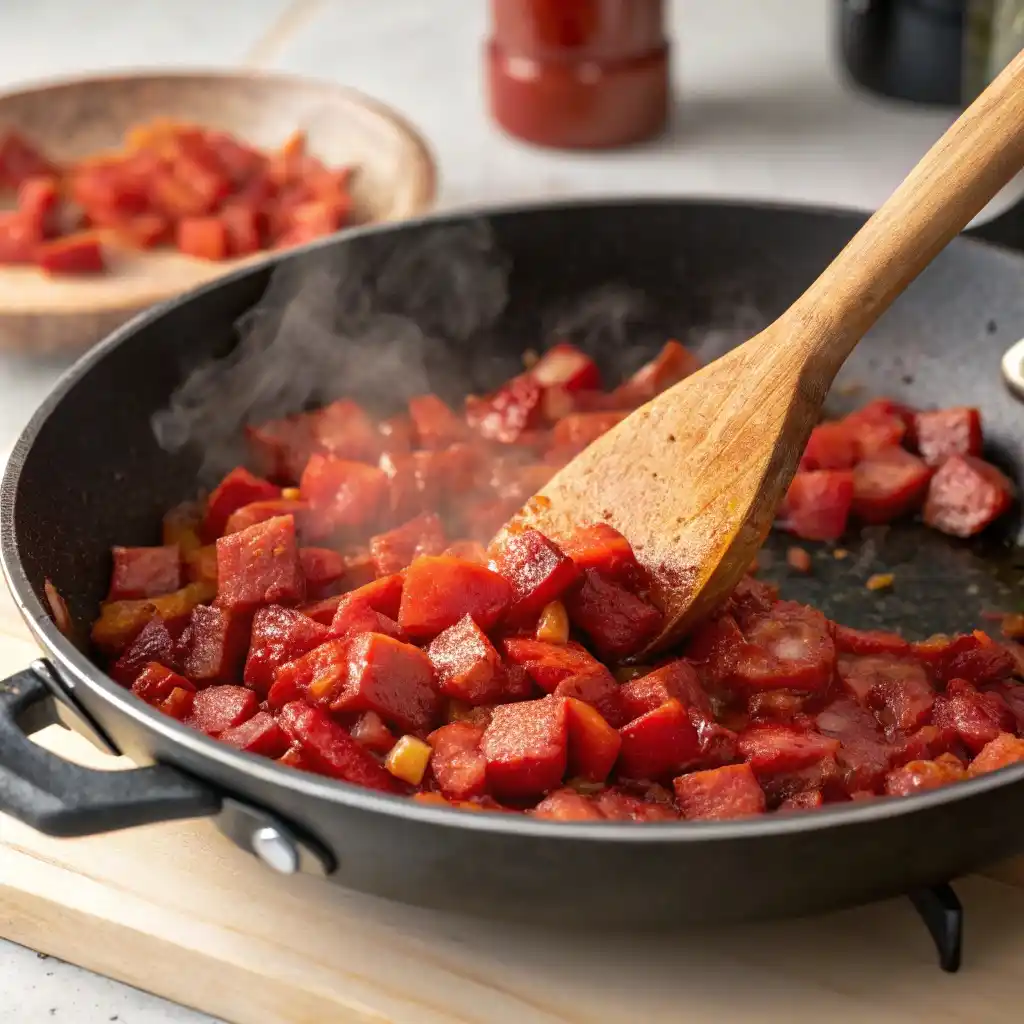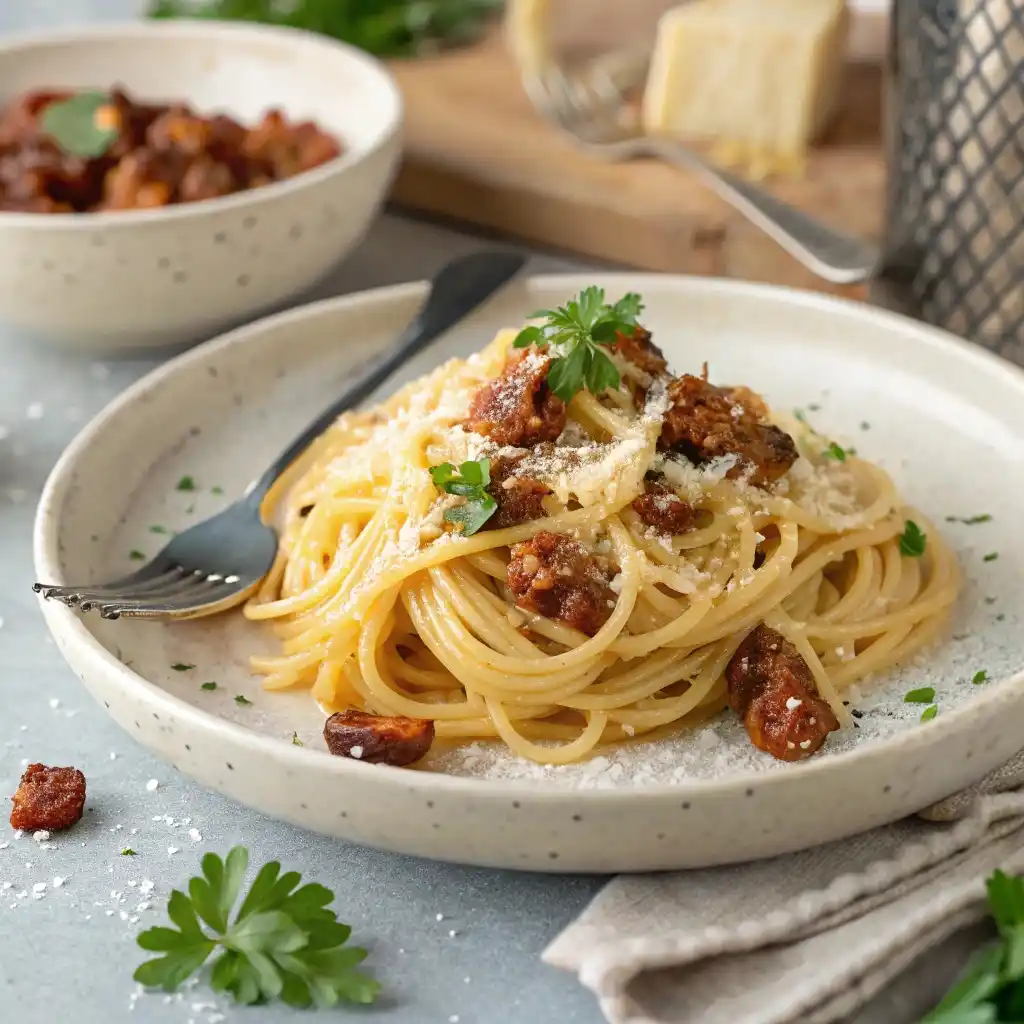If you’re a fan of creamy, cheesy pasta with a rich and smoky flavor, then chorizo carbonara is about to become your new favorite dish. This recipe takes the classic Italian carbonara and gives it a bold, Spanish-inspired upgrade by swapping out pancetta for flavorful chorizo. The result? A decadent pasta dish with a deep, smoky richness that perfectly complements the creamy sauce. Whether you’re making a quick weeknight dinner or impressing friends with your cooking skills, this chorizo carbonara will hit the spot.
Why You’ll Love Chorizo Carbonara
A Bold and Flavorful Twist on Traditional Carbonara
Traditional carbonara is all about simplicity and balance—eggs, cheese, pancetta, and black pepper come together to create a velvety, rich sauce. But when you replace pancetta with chorizo, everything changes. Chorizo is packed with smoky, slightly spicy flavors that infuse the sauce with an irresistible depth. It adds a boldness that transforms the dish from a classic Italian favorite into something completely new and exciting.
Another reason to love this recipe? It’s incredibly easy to make! With just a handful of ingredients and a few simple steps, you can whip up this mouthwatering dish in under 30 minutes.
The Perfect Balance of Creamy and Smoky
What makes carbonara such a beloved dish is its ultra-creamy texture without using heavy cream. Instead, the sauce is made from eggs and cheese, which melt into a silky coating when mixed with hot pasta. The addition of chorizo fat enhances this richness, creating an even more indulgent experience.
But don’t worry—this recipe still keeps the perfect balance! The sharpness of Pecorino Romano or Parmesan cheese cuts through the richness, while black pepper adds a hint of warmth. Every bite is a perfect blend of creamy, salty, and smoky flavors.
Ingredients & Step-by-Step Chorizo Carbonara Recipe

Before we dive into the step-by-step process, let’s break down the ingredients and their roles in making this dish unforgettable.
Essential Ingredients & Their Roles
| Ingredient | Quantity | Role in the Dish |
|---|---|---|
| Spaghetti or fettuccine | 12 oz (340g) | The base of the dish, absorbs the creamy sauce |
| Spanish chorizo (semi-cured) | 4 oz (115g), diced | Adds smoky, spicy flavor and richness |
| Egg yolks | 3 large | Create the creamy sauce without heavy cream |
| Pecorino Romano or Parmesan | ¾ cup (75g), grated | Adds a sharp, salty taste to balance the richness |
| Garlic (optional) | 1 clove, minced | Enhances the depth of flavor |
| Black pepper | 1 tsp | Provides a warm, peppery kick |
| Olive oil | 1 tbsp | Helps render the chorizo and blend flavors |
| Salt | To taste | Enhances all the ingredients |
| Pasta water | ½ cup | Helps bind the sauce and make it silky |
Now that we have everything ready, let’s get cooking!
Step 1: Prepping the Ingredients
Before you start cooking, it’s essential to prepare everything in advance. Carbonara comes together quickly, so having everything ready will help you avoid overcooking or scrambling the eggs.
- Dice the chorizo into small cubes. The smaller the pieces, the better they’ll render their fat into the sauce.
- Separate the egg yolks into a bowl and whisk them together with the grated cheese. This mixture will become your creamy sauce.
- Cook the pasta in a large pot of salted boiling water. Don’t drain it completely—you’ll need some of that starchy pasta water later!
Step 2: Cooking the Chorizo to Release Flavor

This step is where the magic begins! The chorizo’s rich oils will infuse the dish with smoky goodness.
- Heat a pan over medium heat and add a tablespoon of olive oil.
- Toss in the diced chorizo and let it cook for about 3-4 minutes, stirring occasionally. The fat will start to render out, turning the chorizo crispy while creating a flavorful base for the sauce.
- (Optional) If you’re using garlic, add it in the last 30 seconds and stir to prevent burning.
At this point, your kitchen will be filled with the mouthwatering aroma of sizzling chorizo—and that’s how you know things are going right!
Step 3: Creating the Creamy Carbonara Sauce
Here’s where things get exciting: making the sauce without scrambling the eggs!
- Take the pan off the heat to cool slightly—this is important to avoid cooking the eggs too fast.
- Once the pasta is cooked, use tongs to transfer it directly into the pan with chorizo. (A little pasta water clinging to the noodles is a good thing—it helps with the sauce’s consistency.)
- Slowly pour the egg-cheese mixture over the pasta, tossing quickly to coat everything evenly. The residual heat from the pasta will gently cook the eggs, creating a creamy, silky sauce.
- If the sauce looks too thick, add a splash of reserved pasta water (a tablespoon at a time) until it reaches the perfect consistency.
Step 4: Combining Everything for a Perfect Dish
The final step is all about bringing everything together for the best texture and flavor.
- Season with black pepper—lots of it! Traditional carbonara is meant to have a bold peppery kick.
- Give everything a final toss and taste. Adjust salt levels if needed, but remember that cheese and chorizo already bring a lot of saltiness.
- Plate the pasta and sprinkle extra grated cheese on top. If you’re feeling fancy, add a small drizzle of olive oil for an extra glossy finish.
And just like that, your smoky, creamy, and utterly delicious chorizo carbonara is ready to be devoured!
Final Thoughts: A Must-Try Fusion of Flavors
This chorizo carbonara recipe takes the best parts of Italian and Spanish cuisine and fuses them into one unforgettable dish. The creamy egg-based sauce, the bold, smoky kick from chorizo, and the sharpness of Pecorino Romano create a pasta that’s both comforting and exciting.
Perfect for weeknight dinners, special occasions, or just when you’re craving something indulgent, this dish is guaranteed to become a household favorite. So why not give it a try? Once you taste how the smoky chorizo transforms classic carbonara, you’ll never want to go back to the original! 🍝🔥
Common Mistakes & How to Fix Them
Even though chorizo carbonara is simple to make, it’s also easy to mess up if you’re not careful. From scrambled egg sauce to watery textures, small mistakes can ruin an otherwise perfect dish. But don’t worry—I’ve got solutions to fix (or better yet, avoid) the most common pitfalls.
Why Did My Carbonara Sauce Turn Into Scrambled Eggs?
If your sauce turned into a clumpy, scrambled mess, you’re not alone. This is one of the most common mistakes when making carbonara. The key to success? Gentle heat and constant stirring.
❌ The pan was too hot. If you add the egg mixture while the pan is still sizzling, the eggs will cook too fast and scramble instead of turning creamy.
✅ Solution: Remove the pan from the heat for at least 30 seconds before adding the egg mixture. The residual warmth from the pasta will be enough to cook the sauce gently.
❌ You didn’t stir fast enough. The eggs need to mix evenly with the pasta to create a smooth sauce.
✅ Solution: As soon as you pour in the egg mixture, use tongs or a fork to quickly toss the pasta so the sauce coats every strand before it has a chance to clump.
❌ You used whole eggs instead of just yolks. While some recipes call for whole eggs, the whites tend to cook faster and cause a scrambled texture.
✅ Solution: Stick to egg yolks only for a creamier and more stable sauce.
How to Prevent the Sauce from Being Too Watery
Carbonara should be silky, not soupy. If your sauce turns out too thin, here’s what might have gone wrong:
❌ Too much pasta water. While pasta water helps loosen the sauce, too much can make it runny.
✅ Solution: Add pasta water gradually, one tablespoon at a time, until you reach the desired consistency. You can always add more, but you can’t take it out!
❌ Not enough cheese. Cheese helps thicken the sauce by binding with the egg yolks and starch.
✅ Solution: Increase the cheese-to-egg ratio slightly if your sauce feels too thin.
❌ Pasta wasn’t drained properly. If your pasta is still dripping wet, it’ll dilute the sauce.
✅ Solution: Let the pasta drain for a few seconds before adding it to the pan. A little water is good, but too much will throw off the balance.
Choosing the Right Type of Chorizo for Maximum Flavor
Not all chorizo is created equal, and using the wrong type can completely change your dish.
- Spanish Chorizo (Semi-Cured or Cured) ✅ – Best choice! This chorizo is already seasoned and smoked, adding deep flavor to the carbonara. Look for semi-cured chorizo if you want some juiciness, or fully cured chorizo for a firmer texture.
- Mexican Chorizo ❌ – Not recommended. This type is raw and crumbly, meant for frying into a ground meat consistency. It doesn’t have the firm, sliceable texture needed for carbonara.
- Soft Cooking Chorizo ✅ – Another good option! This type of Spanish chorizo is softer and releases a lot of flavorful oils when cooked.
Pro tip: If your chorizo is too oily, drain some of the excess fat before adding the pasta—otherwise, the sauce can become greasy.
How to Serve & Store Chorizo Carbonara
Once you’ve perfected your chorizo carbonara, you’ll want to serve it right and store any leftovers properly to keep it tasting great.
Best Ways to Serve for Maximum Flavor
Carbonara is best served immediately while it’s still warm and creamy. Here’s how to elevate your dish:
🍷 Pair it with the right drink: The richness of carbonara pairs beautifully with a crisp white wine like Pinot Grigio or a light red like Chianti. If you prefer non-alcoholic drinks, a fresh sparkling lemonade works well!
🥖 Add a simple side dish: Serve your pasta with crusty bread to scoop up any leftover sauce or a light arugula salad with lemon dressing to balance the richness.
🧀 Finish with extra cheese: A final sprinkle of Pecorino Romano or Parmesan makes everything taste better!
🌿 Garnish for presentation: While traditional carbonara doesn’t have herbs, a small pinch of chopped parsley or basil can add a fresh touch.
How to Store & Reheat Without Ruining the Texture
Carbonara is notoriously tricky to reheat because the eggs in the sauce can dry out or separate. But if you need to save leftovers, here’s how to do it right.
Storing Chorizo Carbonara:
- Refrigerate in an airtight container for up to 2 days.
- Avoid storing it for too long—carbonara is best when fresh.
Reheating Without Ruining the Sauce:
❌ Don’t microwave! Microwaving will turn the creamy sauce into a dry, grainy mess.
✅ Reheat on the stovetop:
- Place the pasta in a non-stick pan over low heat.
- Add a splash of pasta water or milk to help loosen the sauce.
- Stir constantly for about 2-3 minutes until warmed through.
🔥 Pro tip: If the sauce still feels too dry, you can whisk a small extra egg yolk with cheese and toss it in while reheating to refresh the creamy texture.
Final Thoughts: Enjoy Every Bite of Your Perfect Chorizo Carbonara
Mastering chorizo carbonara takes a little practice, but once you get the technique right, it’s one of the most satisfying and flavorful pasta dishes you’ll ever make.
By avoiding common mistakes, choosing the right ingredients, and following proper storage tips, you can enjoy this smoky, creamy, and utterly delicious dish any time.
So what are you waiting for? Grab some chorizo, eggs, and pasta, and treat yourself to a plate of restaurant-worthy carbonara—with a bold twist! 🍝🔥😋
For more delicious pasta recipes, check out our Vegetarian Carbonara: A Delicious Twist on a Classic Pasta Dish

